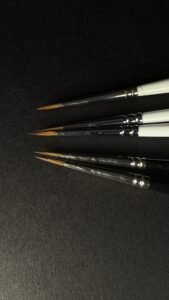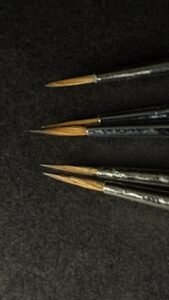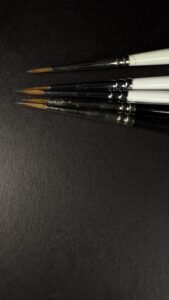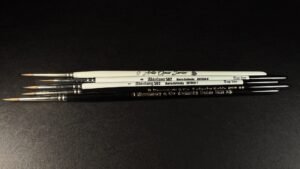Weekly Waffle #379 – Brushing Up
For this week’s Weekly Waffle I have changed up the format a little. Basically this week has been carnage at work and it feels like I have spent half of my life on a train. And for those of you who are familiar with trains in the UK, or at least in the North of the UK, that is not a pleasant experience. They are noisy, hot and you never know quite when they are going to arrive. All that being said they do give you lots of time, usually because they are late, to think about content. So because the hobby time this week has been exceptionally limited I’ve decided to focus on waffling about one of the tools we all use. As opposed to showing you what I’ve managed to do with that tool.
So gather round the painting desk and crack open a drink, because the sun is over the yard arm somewhere, because this week we are going back to basics. We are going to look at the fabled do it all perfectly and make use look good tool. The paint brush.
Now, if you’re anything like me, you’ve probably got an old jam jar full of brushes that look more like they’ve been through a brawl with a Khornate Berserker than used to delicately edge highlight power armour. But every once in a while, we get to have a good ponder about our tools—and none more important than the humble brush.
Whether you’re glazing like a master, dry brushing with reckless abandon, or still figuring out which end the paint goes on (we’ve all been there), this week’s weekly waffle is for you.
First things first what are we actually talking about when we talk about a paint brush. Understanding the main types of brushes you’re likely to see in your in your friendly gaming shop or online store.
Round brushes – These are our workhorses brushes. They’re pointed, good for most jobs, and the majority of miniature painters rely on them. Sizes like 0, 1, or 2 are standard for base coating, layering, and highlighting. Although if you have a good brush with a good sharp tip, and the skill to use it, you can easily paint fine details with a size 3 or brush.
Also when it comes to painting eyes or specifically eyeballs I have cheat that doesn’t involve a paint brush at all. I find that a Sakura Pigma Micron pen works wonders. They are the sorts of pens that are used for technical drawing. The ink is waterproof so once it’s dry it doesn’t run if you apply varnish. It might not be helping me improve my painting skills but I have couple of these in different sizes which are my go to for eyeballs.
Detail brushes – Think 00 or 000. Super fine tips for eyes, freehand, or those pesky purity seals. Not used all the time, but when you need ’them, nothing else will do. One thing I do want to call out with these very small brushes is that they don’t hold a lot of paint. So they can mean you need to visit the same small detail numerous times. Which increases you changes of making a mistake so use them with care.
Flat brushes – These are handy for dry brushing or large surface work, especially terrain or vehicles. A good flat drybrush is worth its weight in lead. I would also include large flat round brushes in this sections if you are interested in taking your dry brushing to the next level.
Kolinsky sable or synthetic? – More on that in a bit, but it’s important to know what you’re picking up. The material matters.
I used to think a brush was a brush, back when I was slapping Boltgun Metal straight from the pot onto Space Marines. Turns out, like most things in this hobby, quality really can make a difference. But I would also say that an expensive brush doesn’t make you a good painter. So you need to find the balance between your painting skill and ambition and the type of brush you pick.
So with that in mind let’s have a look at what we should be thinking about when choosing a brush. The number one thing I check is the tip. Is it sharp? Does it spring back to a point when wet? If not, walk away. A good tip is vital for control, especially when you’re trying to edge highlight something as fiddly as a Harlequin’s sleeve or do pupil dots on a 28mm face (madness, but satisfying madness).
Always test new brushes with a bit of clean water and a flick of the wrist. If it won’t hold a point out of the box, it’s not going to get better. I remember buying a cheap set off Amazon in my early hobby days. Five brushes for the price of one posh sable? Bargain! Or so I thought. One drybrush session later, the heads looked like they’d been used to clean a BBQ grill. Lesson learned.
Ah, the great debate. Should you go for high-end natural hair, like Kolinsky sable, or stick with modern synthetics? It’s something that actually came up on our club WhatsApp chat a few weeks ago.
Kolinsky Sable – These are the gold standard. Brands like Windsor & Newton Series 7 or Raphael 8404 are legendary for a reason. They hold a fine tip, load paint well, and are super durable if you treat them right. But they’re not cheap—and yes, they are made from actual animal hair. Which rules them out if you are Vegan so it’s something to remember.
Synthetic – Cheaper, cruelty-free, and improving all the time. They don’t hold quite as much paint, and tips can splay quicker, but for base coating or rougher work, they’re great. I keep a few on hand for metallics or weathering when I don’t want to wreck a sable.
In my own toolkit, it’s a mix. Sable for detail work, synthetic for metallics and dry brushing. I’ve used Army Painter, BrokenToad, Rosemary & Co., Artis Opus, Citadel, and more brushes. Each has their place—just depends what I’m painting and how flush the hobby budget is that month.
Don’t overlook the brush construction. The ferrule (the metal bit that holds the bristles) should be secure and smooth. If it’s loose or bent, that’s a no-go. I’ve had brushes lose bristles mid-stroke and ruin a near-finished banner. No one wants to be repainting a freehand Imperial Aquila at 11 PM.
Handle shape also plays a part. Some people like the fat ergonomic Citadel handles, others prefer slender sticks like you’d get with an artist’s brush. It’s all about comfort. Try a few and see what feels natural in your grip.
There are also cheap grips that work with paint brushes. So if your favourite brush has a skinny handle and you need something a bit larger the grip just slides onto the brush. Not something I’ve used but something to consider if you are struggling to find that perfect match.
So how much should you pay for a brush. It’s tempting to go budget—especially if you’re new and not sure how long you’ll stick with the hobby—but investing in a couple of good brushes will improve your experience tenfold.
Let’s break it down:
A cheap synthetic brush might cost £3 – £5 but might only last a few weeks before the tip is shot.
A decent sable brush on the other hand might cost £10 – £15 and if you look after it could easily last six months or more.
A pro level brush is easily going to set you back £20+ but if you look after it could last for over a year.
I think of it like tools in any trade. You wouldn’t paint your house with a sponge, so why treat a Primaris Lieutenant any different?
I’d be remiss if I didn’t mention brush care. Even the best brush will die an early death if you mistreat it. A few simple steps, on a regular basis can make a massive difference to the life span of a brush. Which really matters if you are paying top dollar for a top end brush.
Rinse frequently – Don’t let paint dry in the bristles.
Use brush soap – Masters Brush Cleaner is the gold standard. It’s like a spa day for your brushes.
Shape the tip after every session.
Store upright or flat, never bristles-down.
My oldest brush is a battered but beloved Artis Opus size 1 ” It’s done eyes, edge highlights, even transfers. Bit frayed now, but still perfect for texture work. A good brush becomes a companion, really.
At the end of the day, painting minis is about control—and your brush is your sword, your scalpel, your wand. Finding the right one is like picking a favourite pair of dice or your go-to mug for hobby time. It’s personal, practical, and sometimes even a little bit sentimental.
So next time you’re eyeing up your next hobby purchase, give your brushes some thought. That new box of Storm Boys can wait—your tools are what really make the difference between a chore and a joy. And don’t be afraid to try something different. I’ve been using Artis Opus for a while now and really like them. And no there is no sponsorship here. I just find their quality, price and availability work for me.
But in the WhatsApp chat that I mentioned above someone said they have been using Abteilung 502 brushes so I got a couple to try. And I have to say I’m really liking them. I couldn’t say that they are better or worse than the Artis Opus brushes. They are just a bit different.
And I think that can make a big difference to how you paint. Because the brush feels different to me I have been having to concentrate a little more on everything that I do. It’s helped to stop me becoming complacent. So whilst this has nothing directly to do with the brush trying something new can help you improve your painting. And it’s given me another brush that I like working with.
Over time I’m expecting to have both types of brushes in use at the same time where I will use one for one technique and one for another. Simple because a different brush helps me. But you need to find what works best for you.
That’s it for this week. I hope that has given you some food for thought and encouraged you keep paining. My schedule for next week is once again manic so I don’t know if I will have anything painted up for you. Or if I’ll be picking on a different tool to provide some contend. Either way I’ll be back here next week so until then I hope you all have fantastic weekend whatever you have planned. And that next week’s grants you all the hobby time you desire.





